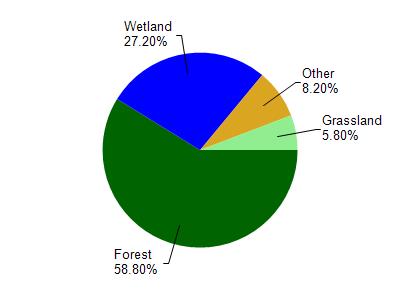Lincoln
No
No
Yes
Fish and Aquatic Life
Overview
Long Lake, in the Prairie River Watershed, is a 119.21 acre lake that falls in Lincoln County. This lake is managed for fishing and swimming and is currently considered impaired.
Date 2012
Author Ashley Beranek
Historical Description
Source: 1982, Surface Water Resources of Lincoln County Long Lake, T34N, R8E, Sec. 13
A very soft water seepage lake having acid, clear water of high transparency. The shoreline is entirely upland consisting of 80 percent hardwoods and 20 percent hemlock. The littoral zone is 65 percent sand, 20 percent silt and 15 percent gravel. Submergent and floating vegetation are sparse over about 20 percent of the lake basin. There is a navigable channel connecting this lake to Bass Lake. Known fish species include muskellunge, largemouth bass, bluegill and pumpkinseed. Public access is provided by 2 county boat landings with limited parking. There are 127 dwellings along the shoreline.
Surface Acres = 132.4, Maximum Depth = 62 feet, Secchi Disc = 20 feet
Date 1982
Author Surface Water Inventory Of Wisconsin
Impaired Waters
Long Lake was put on the Impaired Waters List in the 2012 cycle for mercury in fish tissue. A specific fish consumption advisory is in effect for this lake. Evaluations every two-year cycle from 2012 to 2022 of phosphorus and chlorophyll indicated a healthy system.
Date 2022
Author Ashley Beranek
Condition
Wisconsin has over 84,000 miles of streams, 15,000 lakes and milllions of acres of wetlands. Assessing the condition of this vast amount of water is challenging. The state's water monitoring program uses a media-based, cross-program approach to analyze water condition. An updated monitoring strategy (2015-2020) is now available. Compliance with Clean Water Act fishable, swimmable standards are located in the Executive Summary of Water Condition in 2018. See also the 'monitoring and projects' tab.
Reports
Management Goals
Wisconsin's Water Quality Standards provide qualitative and quantitative goals for waters that are protective of Fishable, Swimmable conditions [Learn more]. Waters that do not meet water quality standards are considered impaired and restoration actions are planned and carried out until the water is once again fishable and swimmable
Management goals can include creation or implementation of a Total Maximum Daily Load analysis, a Nine Key Element Plan, or other restoration work, education and outreach and more. If specific recommendations exist for this water, they will be displayed below online.
Monitoring
Monitoring the condition of a river, stream, or lake includes gathering physical, chemical, biological, and habitat data. Comprehensive studies often gather all these parameters in great detail, while lighter assessment events will involve sampling physical, chemical and biological data such as macroinvertebrates. Aquatic macroinvertebrates and fish communities integrate watershed or catchment condition, providing great insight into overall ecosystem health. Chemical and habitat parameters tell researchers more about human induced problems including contaminated runoff, point source dischargers, or habitat issues that foster or limit the potential of aquatic communities to thrive in a given area. Wisconsin's Water Monitoring Strategy was recenty updated.
Grants and Management Projects
Monitoring Projects
| WBIC | Official Waterbody Name | Station ID | Station Name | Earliest Fieldwork Date | Latest Fieldwork Date | View Station | View Data |
|---|
| 1001000 | Long Lake | 10022146 | Long Lake | 4/20/2010 | 5/9/2014 | Map | Data |
| 1001000 | Long Lake | 353122 | Long Lake - Deep Hole | 8/13/1973 | 8/28/2025 | Map | Data |
| 1001000 | Long Lake | 10022931 | Long Lake | 8/17/2007 | 7/22/2024 | Map | Data |
| 1001000 | Long Lake | 10015046 | Long Lake/Bass Lake - Treaty Chain | | | Map | Data |
| 1001000 | Long Lake | 10018786 | Long Lake -- Access at SE Side Of Lake Off Cth B And 7 Island Lake Rd | 6/12/2010 | 6/18/2025 | Map | Data |
|

Watershed Characteristics
Long Lake is located in the Prairie River watershed which is 263.99 mi². Land use in the watershed is primarily forest (58.80%), wetland (27.20%) and a mix of grassland (5.80%) and other uses (8.20%). This watershed has 273.14 stream miles, 2,082.78 lake acres and 34,162.59 wetland acres.
Nonpoint Source Characteristics
This watershed is ranked Medium for runoff impacts on streams, Medium for runoff impacts on lakes and Low for runoff impacts on groundwater and therefore has an overall rank of Low. This value can be used in ranking the watershed or individual waterbodies for grant funding under state and county programs.However, all waters are affected by diffuse pollutant sources regardless of initial water quality. Applications for specific runoff projects under state or county grant programs may be pursued. For more information, go to surface water program grants.